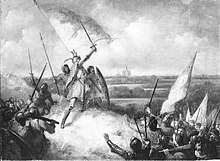Witte van Haemstede
Witte van Haemstede (1280/1282–1321) was a bastard son of Floris V, Count of Holland. His half-brother John I, Count of Holland, gave him the property of Haamstede, in Southern Holland. He married Agnes van der Sluys, sometime before 1307. Their descendants were the Lords of Haamstede.[1]

(by Jacobus van Dijck)
Manpad
In 1304 he led an army to victory in a battle against the Flemish, who were threatening the city of Haarlem. He is said to have defeated the Flemish near Heemstede with the help of the Haarlemmers at the site of the Manpad.
In 1817 Mr. David Jacob van Lennep, who lived in the stately house called Huis te Manpad next to the Manpad, encouraged the Heemstede council to erect a monument. Van Lennep had already composed a romantic song about Witte van Haemstede that was quite popular. The legend says that Witte van Haemstede arrived by ship at Zandvoort and traveled overland to Haarlem over the Manpad, to help the Haarlemmers in their battle against the Flemish who had traveled overland from Hillegom and Lisse. This monument is called 'De Naald' (The Needle).[2]
References
- Cawley, Charles, Count Holland and Frisia, Chapter 2. COUNTS OF HOLLAND (900)-1299, Medieval Lands database, Foundation for Medieval Genealogy,
- F.W.N.Hugenholz, Historie en historiografie van de slag aan het Manpad (1304) Historical essay from 1954 published in Jaarboek van de Maatschappij der Nederlandse Letterkunde, 1954–1955, now in the DBNL